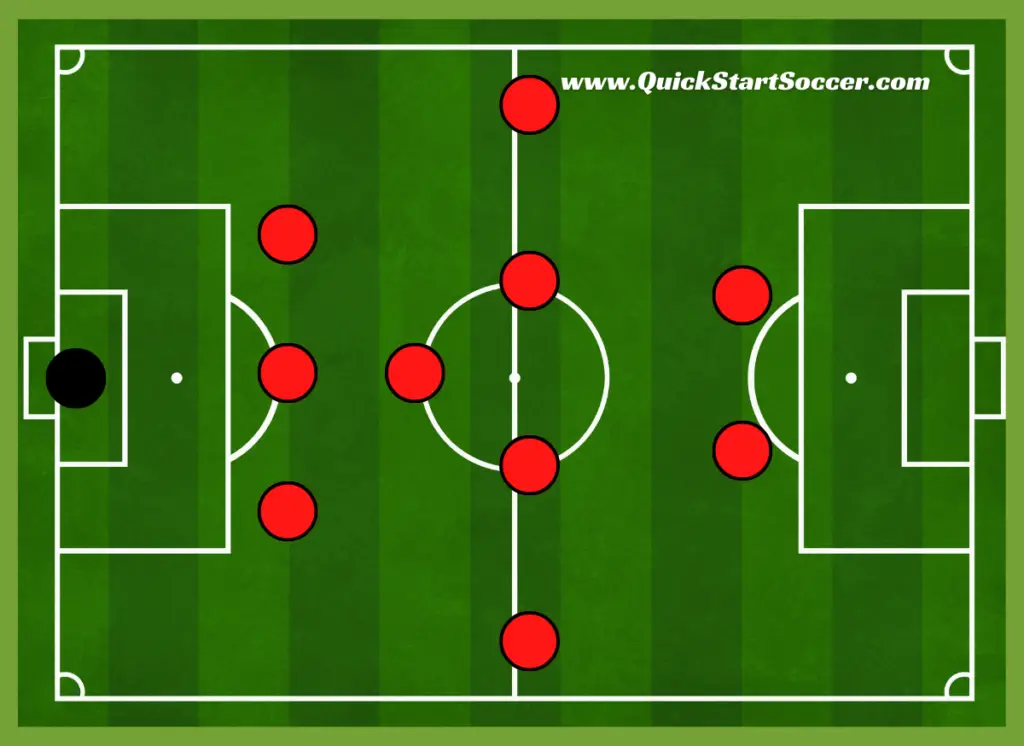3-5-2 Formation Explained | Tactics, Strengths, And Weaknesses
The 3-5-2 formation is once again gaining popularity in youth, college, and professional soccer. As teams and coaches look to outwit their opponents, finding alternatives to the 4-3-3 formation can provide a tactical advantage that can be the difference between winning and losing. But what is the 3-5-2 formation, and how is it used in soccer?
Below you’ll find a detailed guide to the 3-5-2 soccer formation, along with its strengths and weaknesses. We’ll discuss how to play the 3-5-2 and the best formation to counter it. We’ll also look at some of the strongest professional teams playing the 3-5-2 in the modern game. First, let’s look at what the 3-5-2 formation in soccer is.
What Is The 3-5-2 Formation In Soccer?

The 3-5-2 formation in soccer consists of three central defenders, two wing-backs (one left and one right), three central midfielders, and two central strikers. In the modern game, the three central defenders almost always operate as a flat-back 3, with a central defender, a left-sided central defender, and a right-sided central defender. Ahead of the back 3 are the wing-backs. They provide the width for the team in both defense and attack. When defending, they can drop deep to create a defensive back 5; when attacking, they can push forward with the strikers to create an attacking front 4.
Depending on the coach’s preference, the three central midfielders can line up in several ways. The most common of which is to have two central defensive midfielders (CDMs) and a central attacking midfielder (CAM). Alternatively, the coach may want the midfielders to line up with one CDM and two CAMs or even as a simple flat midfield 3. However, both of these variations are less common.
The final characteristic of the 3-5-2 is the strike partnership up top, known as a front 2. The strikers can either play as two traditional number 9’s (i.e., side by side) or with one dropping slightly deeper in what would be viewed as an old-school number 10 role.
How Many Defenders Are In The 3-5-2 Formation?
There are three central defenders in the 3-5-2 formation, plus two wingbacks. The wingback position is a hybrid position that blends the responsibilities of traditional full-backs and wingers. As such, you could argue that a team playing 3-5-2 has five defenders when out of possession. This is most clearly visible when a 3-5-2 playing team faces a much stronger opponent and has to defend for most of the game.
3-5-2 Formation Strengths And Weaknesses
Strengths
The main strength of the 3-5-2 formation is the flexibility that the wing-backs offer the team in and out of possession.
Defensively, having three central defenders means there is a solid core of players directly in front of the team’s goal, which can make it hard for opponents to penetrate and create goalscoring opportunities. When the wing-backs drop back to defend, the back 3 becomes a back 5. A back 5 can be extremely difficult to break down if sufficiently organized and well-coached.
Offensively, having the wing-backs push on to join the attack gives the team great width whilst still maintaining a strong central threat with the team’s two strikers.
In the center of the field, the presence of three midfielders also makes dominating possession a strong possibility. Finally, the utilization of at least one central attacking midfielder means that an additional player, or players, can push on and join the attacks. By combining with the wing-backs and central strikers, these additional players can easily create overloads and destabilize the opponent’s defense.
Weaknesses
As highlighted above, the 3-5-2 can be an incredibly strong and effective soccer formation. However, it is not without its weaknesses. A significant weakness of the 3-5-2 formation is the huge reliance on high-quality players in the wing-back position. In this formation, wing-backs have significant responsibilities in both attack and defense. They must have strong stamina and speed to continually get up and down the field. They also need the ability to create chances for their team and deny chances for their opponents. If they are weak in any of these areas, the team’s wing-backs can easily be exploited in defense and nullified in attack.
Another weakness of the 3-5-2 formation is that it is vulnerable to overloads in wide areas. This is particularly true when playing against teams that utilize attacking full-backs in the 4-3-3 formation.
Best Formation To Counter The 3-5-2
The best formation to counter the 3-5-2 is the 4-2-3-1. In the 4-2-3-1 formation, a team can match their 3-5-2 playing opponents in central midfield areas. They do this through the utilization of two central defensive midfielders and a central attacking midfielder. The 4-2-3-1 formation also offers the chance for attacking overloads in wide areas. With a full-back and a winger on each side of the field, the two players match up against a singular wing-back and can exploit them with quick combination play and crosses into the box. By matching a 3-5-2 playing team in central midfield and outnumbering them in wide areas, a team playing 4-2-3-1 has every chance of success.
What Teams Use The 3-5-2 Formation?
Antonio Conte’s Tottenham Hotspurs
Antonio Conte is undoubtedly one of the most high-profile coaches that currently utilize the 3-5-2 on a regular basis. Currently, at Tottenham Hotspurs, the 3-5-2 offers him the opportunity to get the most out of the devastating attacking partnership of Harry Kane and Son Heung Min. Although he has yet to win a trophy at Spurs, the formation won him the league title in each of his last three coaching assignments at Juventus, Chelsea, and Inter Milan.
Graham Potter’s Chelsea
The former Brighton Coach is no stranger to switching formations from game to game, but 3-5-2 is certainly one of his ‘go-to’ formations in the big ones! By utilizing fast, aggressive, and skillful players in the wing-back role, Potter is able to put teams on the back foot while dominating possession in the middle of the park.
More Formation Guides
One of the things that makes soccer such a fascinating sport to watch, coach, and play, is the variety of tactics and formations that can be utilized to maximize a team’s chances of winning on the day. Before you go, be sure to check out some of our other formation guides below to see the strengths and weaknesses of each of these formations and how teams are using these to up their game.







